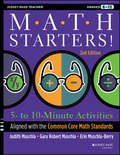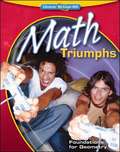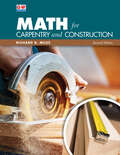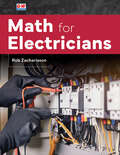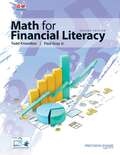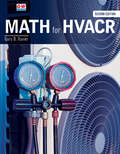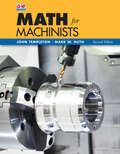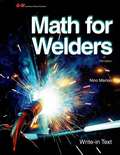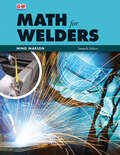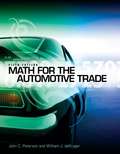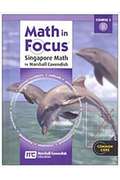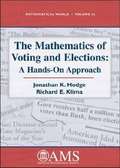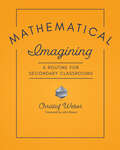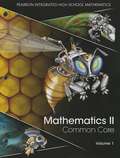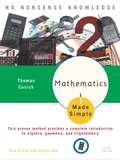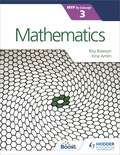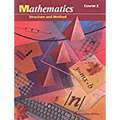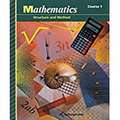- Table View
- List View
Math Starters: 5- to 10-Minute Activities Aligned with the Common Core Math Standards, Grades 6-12
by Gary Robert Muschla Erin Muschla Judith A. MuschlaA revised edition of the bestselling activities guide for math teachers Now updated with new math activities for computers and mobile devices—and now organized by the Common Core State Standards—this book includes more than 650 ready-to-use math starter activities that get kids quickly focused and working as soon as they enter the classroom. Ideally suited for any math curriculum, these high-interest problems spark involvement in the day's lesson, help students build skills, and allow teachers to handle daily management tasks without wasting valuable instructional time. A newly updated edition of a bestselling title Ideal for math teachers in grades six through twelve Includes more than 650 ready-to-use starter problems
Math Triumphs: Foundations for Geometry
by Mcgraw-Hill StaffMath Triumphs is an intensive intervention resource for students who are two or more years below grade level. The series accompanies Glencoe Algebra 1,Geometry, and Algebra 2 and provides step-by-step intervention, vocabulary support, and data-driven decision making to help students succeed in high school mathematics.
Math for Carpentry and Construction
by Richard B. MilesMath for Carpentry and Construction is designed to help carpentry and construction students learn and apply basic math skills. The basic concept behind each math operation is explained at the opening of the unit. Next, students are given clear instruction for performing the operation. Each unit includes a variety of carpentry-and construction-related practice problems to reinforce what the students have learned. The practice problems are identical to the types of problems the students will be required to solve in a carpentry shop or on a construction site. In addition to teaching basic math concepts, the problems give students a preview of the types of challenges they will face in a work environment. This helps the students develop solid troubleshooting skills that will serve them throughout their careers as carpenters and builders.
Math for Electricians
by Rob ZachariasonMath for Electricians provides a review of basic math within a framework of electrical applications, helping students gain confidence and achieve success in math-based electrical tasks. The author has taken a practical approach to cover the basic math concepts used by electricians and other electrical industry professions, beginning with a refresh of basic mathematical operations and continuing with whole numbers, common fractions, decimal fractions, percentages, ratios, proportions, systems of measurement, electrical calculations, and algebraic, geometric, and trigonometric functions. Each mathematical concept relates to an industry application with real-world examples and practice problems. Answers to odd-numbered practice problems are listed in the back of the text.
Math for Financial Literacy
by Todd Knowlton Paul Gray Jr.This book prepares your students for the real world. Written specifically for teens, Math for Financial Literacy provides instruction for relevant math concepts that students can easily relate to their daily lives. <p><p> In Math for Financial Literacy, students learn how to apply basic math concepts to the tasks they will use in the real world, including earning a paycheck, managing a bank account, using credit cards, and creating a budget. Other practical topics are presented to help students become financially capable and responsible. Each chapter is designed to present content in small segments for optimal comprehension.
Math for Financial Literacy
by Todd Knowlton Paul Gray Jr.Written specifically for teens, Math for Financial Literacy helps prepare students for the real world by teaching them how to apply basic math concepts to the tasks they will use in their everyday lives, such as managing a bank account, using credit cards, and creating a budget. Each chapter is structured to help students understand why money and math skills are crucial for professional and personal success with concept previews, warm-ups, demonstrations with numbered steps, and immediate reinforcement followed by review activities. Students engage with technology skills and computational thinking throughout real-world scenarios and end of chapter assessment. The 2nd edition has been updated to include contemporary examples and to reflect changes to tax forms, tuition costs, and digital banking practices.
Math for HVACR
by Gary B. XavierMath for HVACR provides a review of basic math within a framework of HVACR applications, helping students gain confidence and achieve success in math-based HVACR tasks. Serving as an excellent supplement in introductory HVACR and other mechanical trades courses, the text covers whole numbers, common fractions, decimal fractions, percentages, systems of measurement, electrical calculations, and algebraic, geometric, and trigonometric functions. The author's deep industry experience as an HVACR trainer is reflected in real-world examples, illustrations, and abundant exercises in every chapter, which provide relevance for aspiring technicians. Answers to odd-numbered practice problems are listed in the back of the text.
Math for Machinists
by Mark W. Huth John TempletonThe intent of Math for Machinists is to provide students with a review of basic math operations (whole numbers, fractions, decimals, percentages), measurements, and additional math topics that are directly applicable to machining and manufacturing, such as the precision measurements, angles, area, volume, and gear calculations. Creative problems and pertinent exercises help students develop their math skills as well as their knowledge of the trade. Answers to odd-numbered practice problems are listed in the back of the text.
Math for Welders
by Nino MarionMath for Welders is a combination text and workbook designed to help welding students learn and apply basic math skills. The basic concept behind each math operation is explained at the opening of the unit. Next, students are given clear instruction for performing the operation. Each unit includes a variety of welding related practice problems to reinforce what the students have learned. The practice problems are identical to the types of problems the students will be required to solve in a welding shop. In addition to teaching basic math concepts, the problems give students a preview of the types of challenges they will face in a work environment. This helps the students develop solid troubleshooting skills that will serve them throughout their careers as welders.
Math for Welders
by Nino MarionMath for Welders was developed specifically for welding students at any level, providing a real-world approach to learning math as it applies to welding. The text begins with a basic review of math, and then progresses to more challenging math concepts. The text features hundreds of welding-related and basic math problems to provide real-world experience and prepare students for the same scenarios they will encounter on the job. This new edition includes a second color in the design of the text to help clarify formulas and math examples and increase visual interest.
Math for the Automotive Trade
by John C. Peterson William J. DekrygerMATH FOR THE AUTOMOTIVE TRADE, 5E is an up-to-date, highly practical book that helps readers develop a real-world understanding of math concepts and applications in the modern automotive repair trade. Written at a beginner's level, this book is a comprehensive instructional workbook that shows readers how to solve the types of math problems faced regularly by automotive technicians. Unique to MATH FOR THE AUTOMOTIVE TRADE, 5E are realistic practice exercises that allow readers to determine if their answers fall within manufacturers' specifications and repair orders that are completed by finding the appropriate information in the professional literature and reference material, included in the book's valuable appendices.
Math in Focus: Singapore Math, Course 3B (Common Core Edition)
by Marshall CavendishThis world-class math program comes to you from the country of Singapore, the author made sure that you will enjoy learning math with the interesting lessons you will find in this textbook. The textbook is divided into 2 semesters. Chapters 1-6 are in Book A, Chapters 7-11 are in Book B.
Math of Voting and Elections: A Hands-on Approach
by Jonathan K. Hodge Richard E. KlimaThis book is devoted to the mathematics of politics and social choice and is a junior /senior level course aimed at students from a variety of mathematical backgrounds.
Mathematical Connections: A Bridge to Algebra and Geometry
by Francis J. Gardella Patricia R. Fraze Joanne E. Meldon Marvin S. WeingardenMathematical Connections is a bridge that will take you from where you are in your study of mathematics to algebra and geometry. Since topics in mathematics are connected, this course will also lead you to data analysis and probability.
Mathematical Imagining: A Routine for Secondary Classrooms
by Christof WeberImagine a plastic cup lying on the floor. Give the cup a nudge so that it begins to roll. What does the path it takes look like? So begins the journey that Christof Weber takes you on in Mathematical Imagining: A Routine for Secondary Classrooms . Along the way, he makes the case that the ability to imagine, manipulate, and explain mathematical images and situations is fundamental to all mathematics and particularly important to higher level study. Most importantly, drawing on years of experiments in his own classroom, Weber shows that mathematical imagining is a skill that can be taught efficiently and effectively. Mathematical Imagining describes an original routine that gives students space and time to imagine a mathematical situation and then revise, discuss, and act upon the mental images they create. You can use this creative routine to glimpse into your students' thinking and discover teaching opportunities, while empowering them to create their own mathematics.Inside you’ll find the following: An introduction to the routine including the rationale behind it, facilitation guidance, and classroom examples Modifications to implement the routine in your classroom, even with varying time constraints 37 exercises broken into four categories: constructions, problem-solving, reasoning, and paradoxes Discussions of the mathematics involved in each exercise, including possible follow-up questions Instructions on how to create your own exercises beyond the book This one-of-a-kind resource is for secondary teachers looking to inspire student creativity and curiosity, deepen their own subject matter knowledge and pedagogical content knowledge, and invite all students to access the power of their own mathematical imaginations.
Mathematical Models with Applications
by Ralph Bertelle Judith Bloch Roy CameronNIMAC-sourced textbook
Mathematics A
by Isidore Dressler Edward P. KeenanThis text has been written to provide effective teaching materials for a unified program appropriate for ninth- and tenth-grade mathematics students, including all topics contained in the Core Curriculum.
Mathematics II, Common Core, Volume 1
by Randall I. Charles Allan E. Bellman Sadie Chavis Bragg Basia Hall Dan Kennedy Grant Wiggins William G. Handlin Art Johnson Laurie E. Bass Stuart J. MurphyNIMAC-sourced textbook
Mathematics II, Common Core, Volume 2
by Randall I. Charles Allan E. Bellman Sadie Chavis Bragg Basia Hall Dan Kennedy Grant Wiggins William G. Handlin Art Johnson Laurie E. Bass Stuart J. MurphyNIMAC-sourced textbook
Mathematics Made Simple (Sixth Edition)
by Thomas CusickThis book serves as a review of arithmetic, and an introduction to algebra, geometry, and trigonometry and probability.The exercises and answers in this book provide readers with opportunities to test their mastery of each topic in these common branches of mathematics.
Mathematics for the IB MYP 3
by Rita Bateson Irina AmlinA concept-driven and assessment-focused approach to Mathematics teaching and learning.- Approaches each chapter with statements of inquiry framed by key and related concepts, set in a global context- Supports every aspect of assessment using tasks designed by an experienced MYP educator- Differentiates and extends learning with research projects and interdisciplinary opportunities- Applies global contexts in meaningful ways to offer an MYP Mathematics programme with an internationally-minded perspective
Mathematics in Action: Algebraic, Graphical and Trigonometric Problem Solving (Fourth Edition)
by Consortium for Foundation MathematicsThe third book of the Mathematics in Action series, Algebraic, Graphical, and Trigonometric Problem Solving, Fourth Edition, illustrates how mathematics arises naturally from everyday situations through updated and revised real-life activities and the accompanying practice exercises. Along with the activities and the exercises within the text, MathXL® and MyMathLab® have been enhanced to create a better overall learning experience for the reader. Technology integrated throughout the text helps readers interpret real-life data algebraically, numerically, symbolically, and graphically. The active style of this book develops readers' mathematical literacy and builds a solid foundation for future study in mathematics and other disciplines.
Mathematics: Structure and Method (Course 1 #2)
by Mary P. Dolciani Robert H. Sorgenfrey John A. GrahamThis book covers a variety of topics under mathematics ranging from Probability, Rational Numbers, Equations, and Algebra, along with useful problem solving techniques.
Mathematics: Structure and Method, Course 1
by Mary P. Dolciani Robert H. Sorgenfrey John A. GrahamMathematics: Structure and Method, Course 1 is a resource book for students of Mathematics.
